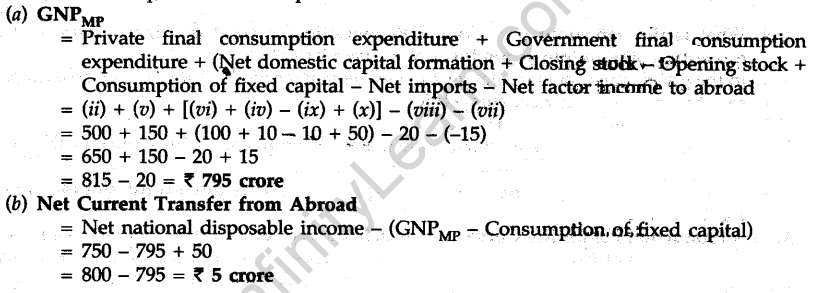Table of Contents
CBSE Sample Papers for Class 12 Economics Delhi -2012
Time allowed : 3 hours Maximum marks 100
GENERAL INSTRUCTIONS
- All questions in both the sections are compulsory.
- Marks for questions are indicated against each.
- Questions No. 1-5 and 17-21 are very short-answer questions carrying 1 nick each. They are required to be answered in one sentence each.
- Questions No. 6-10 and 22-26 are? short-answer questions carrying 3 marks each. Answers to them should normally not exceed 60 words each.
- Questions No. 11-13 and 27-29 are also short-answer questions carrying 4 marks each. Answers to them should normally not exceed 70 words each.
- Questions No. 14-16 and 30-32 are long-answers questions carrying 6 marks each. Answers to them should normally not exceed 100 words each.
- Answers should be brief and to the point and the above word limit should be adhered to as far as possible.
SET I
SECTION A
Question.1. Give meaning of an Economy.
Answer. The term economy refers to all the production units in an area by which people get their living.
Question.2. What is Market Demand?
Answer. Market demand is the sum total of demand by all the consumers of a commodity at a price during a given period of time.
Question.3. What is the behaviour Of average fixed cost as output increases?
Answer. When output increases average fixed cost (AFC) falls continuously.
Question.4. What is the behaviour of average revenue in a market in which a firm can sell more only by lowering the price?
Answer. The average revenue will continuously fall when output increases in a market where a firm can sell more by lowering the price.
Question.5. What is a price taker firm?
Answer. A firm is said to be a price taker when it has no role in the price fixation of a commodity and has to accept the price determined by the whole industry.
Question.6. What is opportunity cost? Explain with the help of a numerical example.
Answer. Opportunity cost is the next best alternative foregone in choosing a given alternative.
For example: Say on a given piece of land either rice or wheat can be grown. On this piece, if rice is grown its yield will be 10 tonnes. On the other hand, if wheat is grown its yield will be 8 tonnes. As rice is grown wheat cannot be grown. In other words, we forego wheat for growing rice. Therefore, in the given illustration, opportunity cost of 10 tonnes of rice is equal to 8 tonnes of wheat. Similarly, if we decide to cultivate wheat, then we have to forego rice production. In that case opportunity cost of wheat is the quantity of rice which we forego, i.e., 10 tonnes of rice.
Question.7. Given price of a good. How does a consumer decide as to how much of that good to buy?
Answer. See Q. 11, 2011 (II Delhi).
Question.8. Draw Average Variable Cost, Average Total Cost and Marginal Cost Curves in a single diagram.
Answer.
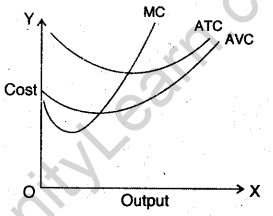
For Blind Candidates only in lieu of Q. No. 8 Explain the relation between Marginal Cost and Average Variable Cost.
Answer. Relation between marginal cost and average variable cost:
– When Marginal Cost (MC) < Average Variable Cost (AVC), AVC falls.
– When Marginal Cost = Average Variable Cost, AVC is constant.
– When Marginal Cost > Average Variable Cost, AVC rises.
Question.9. An individual is both the owner and the manager of a shop taken on rent. Identify implicit cost and explicit cost from this information. Explain.
Answer. In the given case, rent of the shop is explicit cost because it is the actual cost which has been incurred by the person who is owner and manager of the shop.
On the other hand, the imputed value of salary of the owner is implicit cost. This is so because if the owner had worked elsewhere he would have earned the salary.
Question.10. Explain the implication of large number of buyers in a perfectly competitive market.
Answer. See Q. 10, 2011 (I Outside Delhi).
Or
Explain why are firms mutually interdependent in an oligopoly market.
Answer. In an oligopoly, although firms arc free to take decisions about price and output of the commodity, they are mutually interdependent because they have to take care of the reactions of other firms regarding their price and output decisions. If firms do not take care of the reaction of other rival firms, they may ultimately lose.
Question.11. Define an indifference curve. Explain why an indifference curve is downward sloping from left to right.
Answer. An indifference curve is a locus of points representing many combinations of two goods which give equal satisfaction to a consumer.
An indifference curve is downward sloping because if the consumer has more of one unit of a good, he will have to sacrifice some units of the other good so that the level of satisfaction remains the same.
Question.12. When price of a good is Rs 7 per unit a consumer buys 12 units. When price falls to Rs 6 per unit he spends Rs 72 on the good. Calculate price elasticity of demand by using the percentage method. Comment on the likely shape of demand curve based on this measure of elasticity.
Answer.

Question.13. What does the Law of Variable Proportions show? State the behaviour of total product according to this law.
Answer. The law of variable proportions examines the production function assuming one factor as variable and other as fixed. It shows the pattern of change in total output when only one input is increased, other inputs remaining unchanged. In the short run, units of variable | factor change or increase the total product. In this context three phases or situations can be possible at an increasing rate. These are:
(i) In the beginning, when additional units of a variable factor are employed, total product increases at an increasing rate. This is phase 1.
(ii) After this point if more units of a variable factor are employed, total product also increases but at a decreasing rate. This is phase 2.
(iii) If additional units of a variable factor are still employed, total product starts declining. This is phase 3.
Or
Explain how changes in prices of other products influence the supply of a given product.
Answer. The supply of a commodity depends upon the prices of other related goods also. This can
be seen in the supply of substitute goods. If the price of a commodity X remains constant and the price of its substitute good A increases, the producers would prefer to produce substitute good A.
As a result, the supply of commodity X will decrease and that of substitute good A will increase. This will shift the supply curve of good X leftward. Similarly, an increase in the price of commodity X will lead to decrease in supply of the good A.
Also if the prices of some other products rise, the production of these becomes more profitable, so a firm may shift its resources from given product to production of other products. Thus, supply of given product falls.
Question.14. Explain how do the following influence demand for a good:
(i) Rise in income of the consumer.
(ii) Fall in prices of the related goods.
Answer. (i) Rise in income of the consumer. See Q. 12, 2011 (I Outside Delhi).
(ii) Fall in prices of the related goods. See Q. 12, 2011 (I Delhi).
Question.15. Explain the conditions of a producer’s equilibrium in terms of marginal cost and marginal revenue. Use diagram.
Answer. A producer is said to be in equilibrium when he produces that level of output at which his profits are maximum. According to marginal cost and marginal revenue approach r equilibrium is established at a point where marginal cost and marginal revenue are equal (MC = MR). In this case, the following two conditions should be fulfilled:
(i) As long as marginal revenue is higher than the marginal cost, it is profitable for the r producer, so the firm should keep on producing, but stop at a point when MC = MR. This point is arrived at point E, shown in Diagram (i).
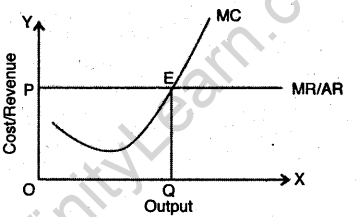
(ii) A situation can be possible when marginal cost (MC) cuts MR at two places as shown in Diagram (ii). In the Diagram up to OQ level of output, MC is more than MR. The firm cannot stop at this point otherwise it will incur losses. In this case, the point of equilibrium will be at point F where MC cuts MR from below. In this case, the level of output is OQ1.
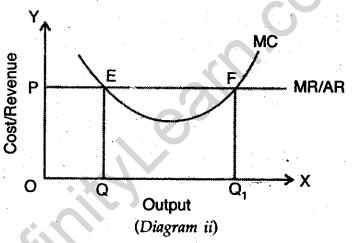
For Blind Candidates only in lieu of Q. No. 15 Explain the conditions of producer’s equilibrium in terms of marginal cost and marginal revenue. Use a schedule.
Answer. (i) According to the schedule given below the level of output will be 3 units because at this level marginal cost and marginal revenue are equal (MC = MR). Before 3 units the producer should not stop producing because he can have excess of revenue up to 3 units and beyond that he will incur losses because MC exceeds MR.
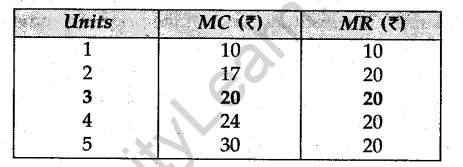
(ii) The level of output cannot be 2 because up to that level MC is higher than MR. In this case, the level of output will be 4 because at this level MC and MR are equal.
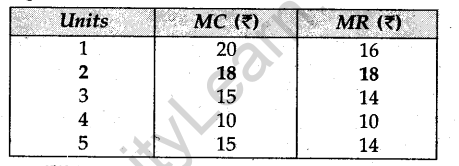
Question.16. Market for a good is in equilibrium. There is simultaneous “increase” both in demand and supply of the good. Explain its effect on market price.
Answer. Equilibrium price of a good in the market is established at a point where its demand and supply are equal. As shown in Diagram (i), the equilibrium price will be OP.
However, if there is simultaneous increase both in demand and supply of the good, the market price will be affected in the following manner:
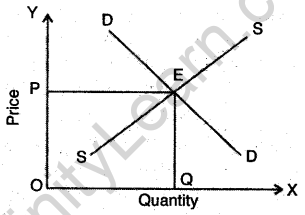
(i) If the relative increase in demand is more than the increase in supply, market price will increase because of excessive demand as shown in Diagram (i) on page 171.
(ii) If relative increase in demand and supply are equal, the market price will remain unchanged as there is neither excess demand nor excess supply as shown in Diagram (ii) on page 171.
(iii) If the relative increase in supply is more than the increase in demand, the market price will fall because of excessive supply as shown in Diagram (iii) on page 171.

Or
Market for a good is in equilibrium. There is simultaneous “decrease” both in demand and supply of the good. Explain its effect on market price.
Answer. In the case of simultaneous decrease both in demand and supply of a good, its market price will be affected in the following manners:
(i) If relative decrease in demand is more than the decrease in supply, the price will fall because of excessive supply as shown in Diagram (i) below.
(ii) If relative decrease in demand and supply are equal, price will remain the same as shown in the Diagram (ii) below.
(iii) If relative decrease in demand is less than the decrease in supply, the price will rise because of excess demand , diagram (iii) below.

SECTION B
Question.17. Define stock variable.
Answer. Stock variable is that whose value is measured at a point of time.
Question.18. Define capital goods.
Answer. Those goods which are used in producing other goods are called capital goods.
Question.19. What are demand deposits?
Answer. Those deposits which can be withdrawn readily by issuing cheques are called demand deposits.
Question.20. Define a Tax.
Answer. A tax is a legally compulsory contribution which is paid to the government.
Question.21. Give meaning of managed floating exchange rate.
Answer. Managed floating exchange rate is that system where the government may intervene in the process of fixation of exchange rate through the central bank.
Question.22. Calculate Gross Value Added at Factor Cost:


Answer.

Question.23. Explain the significance of the ‘Store of Value’ function of money.
Answer. It was virtually impossible to store surplus value under barter economy; the discovery of money has removed this difficulty. With the help of money, people can store surplus purchasing power and use it whenever they want. Money serves as a store of value for goods in liquid form. Saving in the form of money is not only secure but the possibility of it being destroyed is very less. Besides, money can be carried wherever it is needed. By facilitating accumulation of money, money has become the only basis of promoting capital formation.
Question.24. Outline the steps taken in deriving saving curve from the consumption curve, diagram.
Answer.

For Blind Candidates only in lieu of Q. No. 24 Distinguish between consumption function equation and saving function equation.
Answer. Consumption Function Equation:

Question.25. Find National Income from the following:
Autonomous consumption = Rs 100
Marginal propensity to consume = Rs 0.80
Investment = Rs 50
Answer.

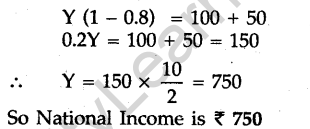
Question.26. Distinguish between Revenue Expenditure and Capital Expenditure in a budget. Give examples.
Answer. See Q. 24, 2011 Comptt. (Ill Outside Delhi).
Or
Explain the role of Government budget in allocation of resources.
Answer. See Q. 27, 2011 (I Delhi).
Question.27. Giving reason explain how should the following be treated in estimating National Income:
(i) Expenditure on fertilizers by a farmer.
(ii) Purchase of tractor by a farmer.
Answer. (i) Expenditure on fertilizers by a farmer is an intermediate cost hence it will not be included in the NationaMncome. R is a part of value of output and not of National Income.
(ii) Purchase of tractor by a farmer is included in National Income because it is an investment by the farmer.
Question.28. Explain the components of Legal .Reserve Ratio.
Answer. Legal reserve ratio is a certain minimum fraction of deposits which is legally compulsory for the commercial banks to keep as cash or in liquid form. There are two parts of this ratio— (i) Cash Reserve Ratio (CRR) and (ii) Statutory Liquidity Ratio (SLR).
Cash reserve ratio is the part of the deposits which is kept with Central bank as reserve in cash.
Statutory liquid ratio is the ratio of deposits which banks have to keep with themselves. In short

Or
Explain ‘bankers’ bank’ function of Central bank.
Answer. Central bank makes policies and regulations for the commercial banks. Commercial banks are required to keep a certain minimum, percentage of their deposits as Cash Reserve with the Central bank. The Central bank uses these reserves to advance loans to the Commercial banks to meet their requirements. This is why the Central bank is called Bankers’ bank .
Question.29. Explain ‘revenue deficit’ in a Government budget? What does it indicate?
Answer. Revenue deficit is equal to the excess of total revenue expenditure over the total revenue receipts. In short:
Revenue deficit = Total revenue expenditure – Total revenue receipts Revenue deficit indicates the extra amount of current expenditure which cannot be met by revenue receipts. This shows the extent of borrowings which are required to meet this deficit. If revenue expenditure increases without a corresponding increase in the revenue receipts, revenue deficit increases and this calls for additional borrowing. This means liability of the government increases.
Question.30. Find out (a) National Income and (b) Net National Disposable Income:


Answer.
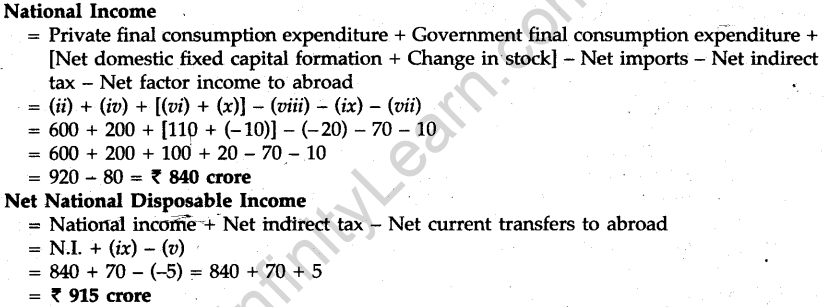
Question.31. Explain the concept of ‘excess demand’ in macroeconomics. Also explain the role of ‘open market operations’ in correcting it.
Answer. If equilibrium level of income is determined after the stage of full employment, it is a situation of excess demand. This means at the full employment level of income, real aggregate demand is. more than the aggregate supply which is required for the full use of resources. The excess of real aggregate demand over the aggregate supply required for operating at full employment level is called excess demand or inflationary gap. As a result of excess demand, prices increase because, corresponding to increase in demand output cannot increase.
A number of methods can*be used for comprehending the situation of excess demand. Open market operations is one of them. This means sale and purchase of government securities by the Central bank in the open .market. Government securities are bought and sold by commercial banks to correct the situation of excess demand and deficient demand. For correcting the situation of excess demand, Central bank should reduce the supply of credit and for that it should sell securities in the open market which will be bought by the commercial banks. This leads to flow of money out of commercial banks and reduces the liquidity position of commercial banks and hence they give less credit. By this decline in the lending capacity of the banks, borrowings decline and their aggregate demand also declines.
Or
Explain the concept of ‘deficient demand’ in macroeconomics. Also explain the role of Bank Rate in correcting it.
Answer. If equilibrium level of income is determined before the stage of full employment, it is a situation of deficient demand. This means the aggregate demand at the equilibrium level of output is less than the aggregate supply at the full employment level. In such a situation due to inadequacy of demand, production will be less and with the result involuntary unemployment will be created. This means that all the resources will not be fully employed. Therefore the deficiency in aggregate demand at full employment level is the measure of deficient demand. It is also called as deflationary gap.
Bank rate is one of the methods which can be used for correcting the situation of deficient demand. Bank rate is the rate of interest which a Central bank charges from the commercial banks for giving them credit. If bank rate is higher, rate of interest is also higher and vice- versa. In the given situation since the volume of credit is to be increased, Central bank should reduce the bank rate so that the rate of interest falls and more credit is sought from commercial banks. This will increase the level of output correcting the situation of deficient demand.
Question.32. Explain the distinction between autonomous and accommodating transactions in balance of payments. Also explain the concept of balance of payments ‘deficit’ in this context.
Answer. distinction between autonomous and accommodating transactions in balance of payments:
See Q. 22, 2011 (III Foreign)
The deficit in balance of payments is determined only by autonomous transactions. When autonomous foreign exchange payments are more than the autonomous foreign exchange receipts, this excess is called balance of payments deficit.
SET II
Note : Except for the following questions, all the remaining questions have been asked in Set I.
SECTION A
Question.6. What is ‘Marginal Rate of Transformation’? Explain with the help of an example.
Answer. Marginal rate of transformation is the rate at which the units of one good have to be sacrificed to produce one more unit of the other good in a two goods economy.
Example: We can explain this with the help of an example. Suppose by employing given resources fully and efficiently the economy produces 1X + 10Y. As such if the economy decides to produce 2X, it has to reduce production of Y by 2 units. Then 2Y is the opportunity cost of producing 1X. In this case MRT is 2Y : 1X.
Question.9. A producer borrows money and opens a shop. The shop premises is owned by him. Identify the implicit and Explicit costs from this information. Explain.
Answer. In the given situation the shop premises is owned by the producer himself. Therefore the rent of the shop is the implicit cost as he would have earned rent if the shop was rented out. The money which the producer borrows from the market, its interest is the explicit cost. It is the actual money expenditure on an input.
Question.11. Define Marginal Rate of Substitution. Explain why is an indifference curve convex?
Answer. Marginal rate of substitution may be defined as the quantity of commodity Y that a consumer is willing to substitute for one unit gain of commodity X. In simple terms, MRS means how much commodity of Y a consumer is willing to sacrifice for one unit gain of commodity X. MRS is always declining.
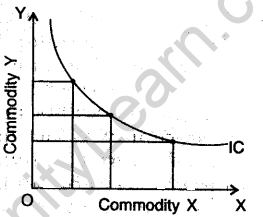
An indifference curve is convex to the origin. Convexity of the curve signifies that it bows inward to the origin. This is simply because MRS is declining continuously, due to the operation of the law of diminishing marginal ( utility. This becomes evident by looking at the diagram
Question.12. A consumer buys 10 units of a good at a price of Rs 9 per unit. At price of Rs 10 per unit he buys 9 units. What is price elasticity of demand? Use expenditure approach. Comment on the likely shape of demand curve on the basis of this measure of elasticity.
Answer.

In this case, according to the expenditure method, since the total expenditure is same, i.e., Rs 90, the elasticity of demand is = -1.
Since TE remains the same, the nature of demand curve will be rectangular hyperbola.
SECTION B
Question.22. Calculate Net Value Added at Factor Cost:

Answer.

Question.25. Find ‘investment’ from the following:
National Income Rs 500
Autonomous Consumption Rs 100
Marginal propensity to consume 0.75
Answer.

Question.27.Giving reason explain how should the following be treated in estimating National Income:
(i) Payment of bonus by a firm
(ii) Payment of interest on a loan taken by an employee from the employer .
Answer. (i) Bonus is included in the estimation of National Income because it is a part of compensation of employees.
(ii) Interest on loan taken by an employee is not included because the loan is taken for consumption purposes.
Question.30. Find out (a) Net National Product at Market Price and (b) Gross National Disposable Income:
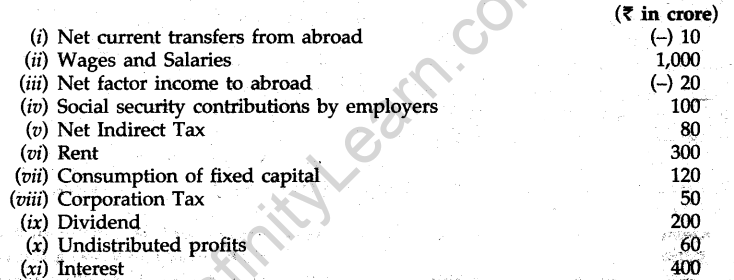
Answer.
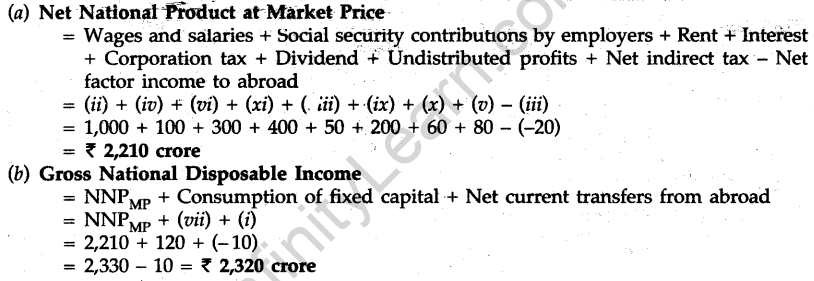
SET III
Note: Except for the following questions, all the remaining questions have been asked in Set I and Set II.
SECTION A
Question.6. State reasons why does an economic problem arise?
Answer. Economic problems arise because of the following facts:
(i) Our wants are unlimited.
(ii) Resources to satisfy unlimited wants are limited.
(iii) Limited resources can be put to alternative uses.
Question.9. A producer invests his own savings in starting a business and employs a manager to look after it. Identify implicit and explicit costs from this information. Explain.
Answer. In the given example, a producer invests his own savings and employs a manager to look after his business. Therefore
- interest on savings is implicit cost because had he lent the savings elsewhere, he would have earned the interest.
- salary paid to the manager is an explicit cost because this is the expenditure which has been actually incurred by the producer.
Question.11. Define an indifference map. Explain why an indifference curve to the right shows higher utility level.
Answer. If there are more than one indifference curves in the graph, the graph is known as indifference map. Every indifference curve represents a level of satisfaction from all the combinations it represents. However, if the level of an indifference curve is higher than the level of another indifference curve, the level of satisfaction will be higher than that indifference curve. Indifference curve to the right shows higher utility level, because each point on the higher curve shows, more goods. Therefore in the absence of any budgetary constraints, a consumer will seek; a combination on the highest indifference curve.
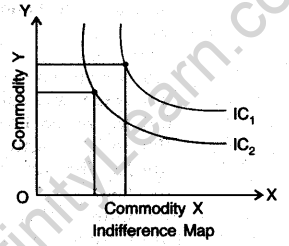
Question.12. A consumer buys 20 units of a good at a price of Rs 5 per unit. He incurs an expenditure of Rs 120 when he buys 24 units. Calculate price elasticity of demand using the percentage method. Comment upon the likely shape of demand curve based on this information.
Answer.
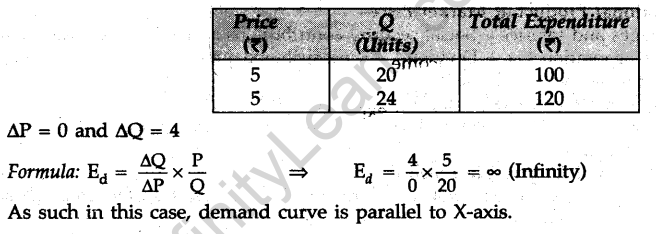
SECTION B
Question.22. Find Net Value Added ^t Market Price:

Answer.

Question.25. Find consumption expenditure from the following:
Autonomous consumption =100 (Rs)
Marginal propensity to consume = 0.70
National Income = 1,000 (Rs)
Answer.
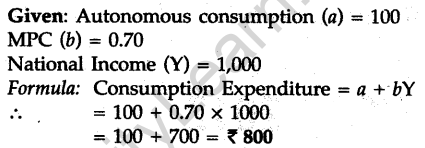
Question.27. Giving reason explain how should die following be heated in estimating National Income: (i) Interest paid by banks on deposits by individuals. (ii) National debt interest.
Answer. (i) Interest paid by Banks to individual is, included in the estimation of National Income because it is a factor payment by a producer.
(ii) National debt interest is not included because it is a transfer payment. This loan is taken for consumption purposes.
Question.30. Find out (a) Gross National Product aGMarket nice and (b) Net Current Transfers from Abroad:
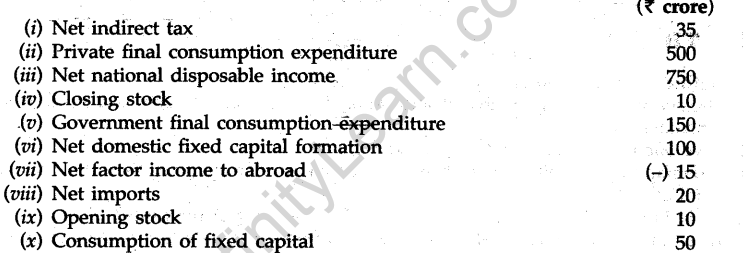
Answer.
